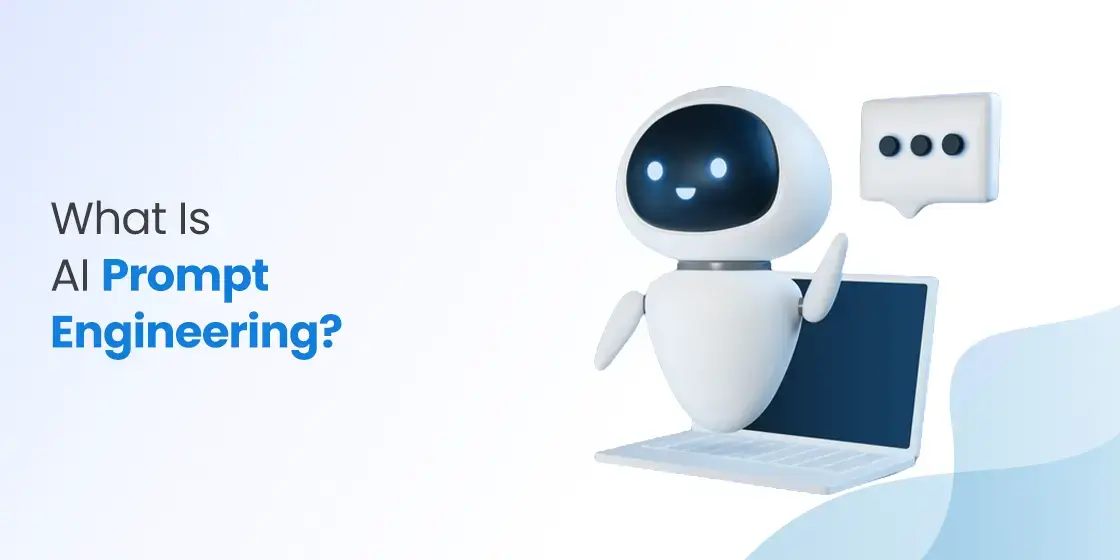Table of Content
Learn About the Utility of AI Prompt Engineering in Different Areas
Artificial intelligence is bringing a wave of transformation for many businesses. It has shown great potential how automation can be achieved by working with the right dataset. The most exceptional feature that has made AI popular in the world is its ability to answer questions accurately. It demonstrates that AI can answer anything in the same manner in which the question has been asked. This is called AI prompt engineering that ensures to facilitate queries in the exact way they have been put in front of the system.
Prompt engineering emphasizes on putting right questions before the generative AI model. It describes that accurate results can only be obtained when a user will ask right questions from the system. Today, we see tools like ChatGPT working so well in the industry due to this very reason. The generative AI model of ChatGPT is quite advanced, as it can answer any type of question in the same manner in which it has been asked. Getting inspired by this, many IT companies are actively working to adopt prompt engineering, so that the quality of their software development services can be scaled efficiently.
In this blog, we will discuss in detail the concept of AI prompt engineering. We will let you know how does it really work to answer every query accurately. But, before moving into the technicalities of this model, let’s first understand the concept of generative AI model. It is important to first get a know how of this technology because AI prompt engineering is entirely based on it.
What is Generative AI Model?

Generative AI models represent a sophisticated category of artificial intelligence systems that are specifically engineered to create new data similar to an existing dataset. These models operate by learning the underlying patterns and structures within the data, enabling them to generate fresh outputs that closely resemble the original information. Unlike discriminative models, which are primarily designed to classify or make predictions based on already observed data, generative models delve deeper into the data’s distribution, striving to understand it so thoroughly that they can produce entirely new examples that appear to be part of the same dataset.
The core function of generative models lies in their ability to mimic the distribution of the input data, which allows them to generate a wide variety of outputs. For example, when trained on a dataset of images, these models can create new images that, while not identical to any in the training set, share similar characteristics, such as style, composition, and content. This capability extends beyond visual data to other forms of media, including text, where generative models can craft coherent and contextually relevant sentences, paragraphs, or even entire articles.
One of the most remarkable aspects of generative AI models is their ability to produce human-like conversations, making them valuable in applications such as chatbots and virtual assistants. By analyzing vast amounts of conversational data, these models learn to understand the nuances of language, enabling them to generate responses that are not only contextually appropriate but also convey a level of human-like understanding and empathy. This feature highlights the potential of generative models to revolutionize various industries by automating content creation, taking human-computer interactions to a newer level.
What is AI Prompt Engineering?

Prompt engineering is a critical technique used to steer generative AI systems toward producing specific, desired outputs. This process involves crafting and refining the instructions, or “prompts,” that are given to the AI to ensure that the generated content aligns with the intended objectives. Although generative AI systems are designed to replicate human-like responses and outputs, they still rely heavily on the clarity and precision of the prompts they receive. Without well-structured guidance, these AI systems may produce results that are either off-target or of lower quality.
At the heart of prompt engineering is the deliberate selection of formats, phrases, words, and symbols that best convey the desired outcome to the AI. This involves a deep understanding of how the AI interprets language and responds to different types of input. By carefully choosing specific words, users can significantly influence the AI’s behavior. This level of detail in crafting prompts is essential for ensuring that the AI can engage with users in a manner that is meaningful and aligns with the specific goals of the interaction.
Moreover, prompt engineering is not just about giving instructions—it’s about creating a dialogue with the AI that enhances its ability to interact with users effectively. This process often requires iterative refinement, where prompts are continually adjusted based on the outputs generated by the AI. Through this ongoing process, the AI can be trained to better understand and respond to complex requests, ultimately leading to more sophisticated and user-friendly interactions. As generative AI continues to evolve, the role of prompt engineering will become increasingly important in maximizing the potential of these systems.
Importance of AI Prompt Engineering

In Dubai, the demand for prompt engineering roles has surged considerably since the advent of artificial intelligence in UAE. As these technologies become more integrated into various applications, prompt engineers have emerged as crucial players in the AI ecosystem. Their primary role is to serve as intermediaries between end users and sophisticated large language models, ensuring that users can effectively interact with these models to achieve optimal outcomes.
Prompt engineers specialize in identifying and crafting scripts and templates that users can adapt and personalize to meet their specific needs. These templates are designed to maximize the efficiency and accuracy of language models, helping users to extract the best possible results. By providing a structured starting point, prompt engineers make it easier for users to engage with AI, minimizing the trial-and-error process that can often accompany the use of advanced technologies.
Moreover, prompt engineers dedicate a significant portion of their efforts to experimenting with a wide variety of inputs. Through this experimentation, they build comprehensive prompt libraries, which serve as valuable resources for application developers. These libraries can be utilized across different scenarios and use cases, enabling developers to implement AI-driven features more seamlessly. By refining and expanding these libraries, prompt engineers play a key role in enhancing the usability and versatility of generative AI across industries.
Use Cases of AI Prompt Engineering

Prompt engineering comes handy in a variety of scenarios. It is not a one-dimensional technology that works in limited areas. Instead, it can help businesses to solve different types of questions by providing to-the-point accurate answers.
Critical Thought Process
Critical thinking applications demand that language models possess the ability to tackle complex problems with a high degree of sophistication. To meet these demands, the model must be capable of analyzing information from multiple perspectives, considering various angles and potential implications. This process involves not only processing the data but also assessing its credibility and reliability. The model must then synthesize this information to make well-reasoned decisions that reflect a deep understanding of the problem at hand.
The role of prompt engineering in this context is crucial, as it significantly enhances the model’s ability to analyze and interpret data effectively. By designing precise and well-structured prompts, engineers can guide the model to focus on the most relevant aspects of the information, thereby improving its analytical performance. These prompts help the model to dissect complex problems, prioritize critical information, and generate responses that are not only accurate but also thoughtfully reasoned.
Domain Knowledge
Prompt engineering is essential in applications where the AI is expected to provide responses that demonstrate subject matter expertise. In many language learning apps in UAE, the quality of the AI’s output hinges on how well it can navigate complex and specialized knowledge areas. A well-crafted prompt is crucial in steering the AI to draw upon relevant information and produce responses that reflect a deep understanding of the subject. This is especially important in fields where accuracy and precision are paramount, such as medicine, law, or technical domains.
An experienced prompt engineer can significantly enhance the AI’s performance by carefully designing prompts that lead the model to consult the most appropriate sources. This involves not only selecting the right keywords but also understanding how to guide the AI in interpreting and synthesizing information from credible references. The prompt engineer’s expertise ensures that the AI’s responses are both accurate and contextually relevant, addressing the specific nuances of the questions posed.
Creative Results
Creativity is the process of generating novel ideas, concepts, or solutions that go beyond conventional thinking. It involves the ability to think outside the box, combine disparate elements in innovative ways. In the context of AI, fostering creativity means guiding the model to produce outputs that are not only original but also meaningful and relevant to the given context. This requires the model to draw upon a wide range of knowledge, synthesize information in unconventional ways, and explore possibilities that may not be immediately obvious.
Prompt engineering plays a crucial role in enhancing a model’s creative capabilities across various scenarios. By carefully designing prompts, engineers can encourage the model to explore different angles, think abstractly, and generate responses that reflect a higher level of creativity. These prompts can be tailored to push the model beyond standard patterns of reasoning, helping it to produce ideas and solutions that are truly innovative. Whether it’s for brainstorming sessions, or problem-solving tasks, prompt engineering can unlock the model’s potential to contribute creatively.
Key Prompt Engineering Techniques to Consider

Software developers can get best results from prompt engineering by following some important techniques. If you do not know much about them or have little understanding of the concept, take a look at the number of options given below.
Chain-of-thought Prompting
Chain-of-thought prompting is a technique designed to deconstruct complex questions into smaller, more manageable components that align with a logical sequence of thinking. By breaking down a problem into these intermediate steps, the model is guided through a structured process that mirrors how a human might naturally approach problem-solving.
Instead of prompting the model to provide a direct answer to a potentially intricate or multifaceted query, chain-of-thought prompting encourages it to work through the problem one step at a time. This approach facilitates a more thorough exploration of the underlying components of the question, leading to a deeper understanding of the problem as a whole.
Tree-of-thought Prompting
The tree-of-thought technique is an advanced extension of the chain-of-thought prompting method. While chain-of-thought prompting involves guiding the model through a linear sequence of logical steps, the tree-of-thought technique broadens this approach by considering multiple potential pathways or solutions simultaneously.
Once the model has generated these potential next steps, the tree-of-thought technique employs a tree search method to systematically evaluate each option. In this context, a tree search involves branching out from the initial problem or question, with each branch representing a different possible step or decision the model could take.
Generated Knowledge Prompting
This technique begins by instructing the model to first generate and identify the pertinent facts or information required to address a given prompt. By focusing on gathering these relevant facts, the model lays a solid foundation of context and details that are crucial for understanding the prompt thoroughly.
Once the relevant facts have been generated and organized, the model proceeds to use this contextual information to complete the prompt. This structured approach allows the model to leverage the newly acquired facts to craft a response that is both accurate and comprehensive.
Benefits of AI Prompt Engineering

AI prompt engineering offers several key benefits, starting with the enhancement of model performance and accuracy. By carefully designing prompts, users can guide AI systems to focus on the most relevant aspects of a problem. This approach helps the model to better understand the context and nuances of the task at hand, leading to outputs that are more aligned with the user’s intentions. Whether the goal is to generate creative content, or provide detailed explanations, effective prompt engineering can significantly boost the quality and reliability of the AI’s performance.
Another major benefit of prompt engineering is the ability to customize and optimize the AI’s behavior for specific tasks or applications. Different prompts can be crafted to elicit different types of responses, allowing users to tailor the AI’s output to meet particular needs. For instance, prompts can be adjusted to encourage the model to take a more formal tone, focus on certain topics, or explore multiple perspectives. This flexibility makes prompt engineering a powerful tool for refining how AI systems interact with users and how they handle various challenges across different domains.
Additionally, AI prompt engineering contributes to the efficiency and effectiveness of AI deployment in practical applications. By reducing the likelihood of errors, well-engineered prompts can save time and resources by minimizing the need for extensive post-processing or manual intervention. This is especially valuable in environments where quick, accurate responses are critical, such as customer services. Overall, the benefits of AI prompt engineering lie in its ability to fine-tune the interaction between humans and AI, leading to more productive and satisfying outcomes.
Frequently Asked Questions
| What is generative AI model? A generative AI model is a type of artificial intelligence that creates new content, such as text, images, or music, by learning patterns from existing data. It uses this knowledge to generate outputs that resemble the original data but are original and novel. |
| What is AI prompt engineering? AI prompt engineering involves crafting specific inputs or “prompts” to guide an AI model’s responses. It’s a technique used to enhance the model’s performance by tailoring how it interprets and processes the input. |
| How to use prompt engineering in the development chatbots? Prompt engineering in chatbot development involves designing precise and context-aware prompts that guide the AI’s responses,. By refining prompts, developers can better control the chatbot’s behavior, improving its ability to understand and respond to diverse queries. |
Final Words
That takes us to the end of this blog in which we have discussed how AI prompt engineering works. It is a creative technology that ensures to provide to-the-point results for every question asked. Based on the concept of generative AI model, prompt engineering facilitates every query with a precise answer. It can be used in a variety of ways to speed up the human-computer interaction process.
The development of AI chatbots is a one fine example in this regard. By using prompt engineering, these chatbots can be programmed to answer every question in the same manner/language in which they have been asked by the user. This is one of the key capabilities of prompt engineering that makes its utility quite high for application developers.

Empower your digital journey with StruqtIO - Your dedicated partner for cutting-edge custom software development, innovation, and digital transformative solutions. Harness the power of technology to elevate your business and redefine your digital landscape today.


